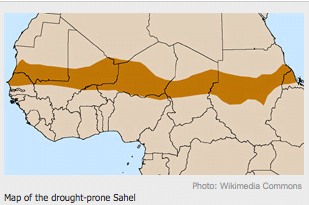As I noted in Top of the Morning, the we are entering into an increasingly dire period for people living in the Sahel region of Africa. This is a belt that runs basically coast to coast in Africa, just south of the southern edges of the Sahara desert.
As the Sahara steadily creeps southward thanks to climate change, the dry spells experienced in this region are becoming lengthier. In late 2009, poor rainfall predicated a terrible harvest in 2010 which plunged 10 million people in Niger, Chad, Mali and Mauritania into a food crisis. Children went malnourished and livestock died in large numbers.
Here we are in the end of 2011 and it looks like this pattern may repeat itself. The US-supported Famine Early Warning System is warning of several “stressed” areas in Mali, Niger, the Central African Republic, Sudan and South Sudan that suffered from poor agricultural production this year. From IRIN:
Governments, UN agencies and NGOs estimate six million people are highly vulnerable to food insecurity and possible related impoverishment and malnutrition in Niger; 2.9 million in Mali; 700,000 – over quarter of the population – in Mauritania; and over two million in Burkina Faso; while in Chad 13 out of 22 of the regions could be affected by food insecurity.
Poor rains in parts of Niger, Mauritania, Chad and Burkina Faso – as well as pockets in other countries in the Sahel – have led to poor cereal production. That, combined with other factors mean for many, the lean season, which traditionally starts in March or April, could come as early as January.
Contributing to Sahelians’ vulnerability are: very high regional food prices – the cost of cereals in the region is 40 percent higher now than the past five years’ average, according to NGO Oxfam; a drought as recently as 2009 which meant despite good rains in 2010 poor farmers and herders had sold off all of their food or animal stocks and not had time to rebuild them; and lost remittances not only from returnee workers from Libya, but also potentially from Europe.
I predict that going into 2012, we are going to be hearing a lot more about this crisis. (Or, at least those of us who pay attention to these things). This is basically the horn of Africa crisis creeping westward. The number of people affected is about the same (11 million) but spread across a wider region. Definitely something to monitor.

